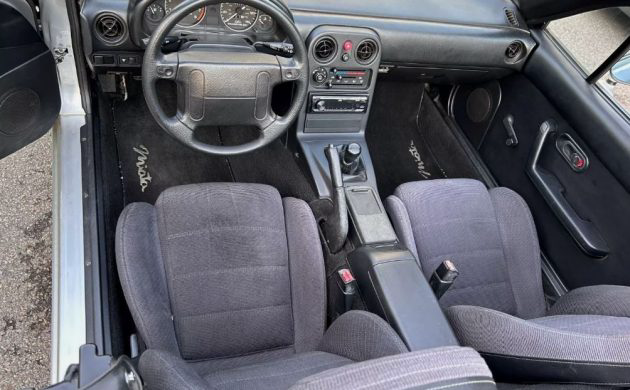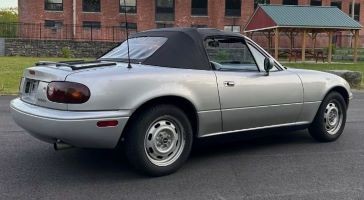Road or Track: 1991 Mazda MX-5 Miata
Consider the poverty of the American car scene in the 1970s. The dominant themes were horsepower reduction and fuel efficiency, sapping fun from the driving experience. Only Japan was meeting our new requirements handily, sending over cars like the Celica and the Corona, and exceeding expectations with the 240Z. But sneaking into the mix was the slightly weird and quite wonderful Mazda RX7. Its Wankel rotary, slanted nose, and generous hatchback proved to be a recipe for sales success. The RX7 was a swan among ducklings in the company’s line-up: Mazda hadn’t made a true sports car since the 1967 launch of the Cosmo. A drop-top arrived eventually, but by then the RX7 had gained at least 300 lbs and a few inches of wheelbase. Reclaiming the pleasure of carving up the road required a new car. Meanwhile, Bob Hall, a journalist with Motor Trend, had captured the ear of Mazda’s head of Research & Development, Kenichi Yamamoto. Hall sketched out his vision of a sports car for Yamamoto – a two-seat roadster in the British tradition but imbued with Japanese reliability. Yamamoto reportedly drove a Triumph Spitfire at Hall’s urging – an apparently convincing experience, because Mazda launched the Miata in 1989.
Today’s example has a few flaws including a collision in its AutoCheck history. The seller claims its 54,043 miles are documented via a thick receipt folder showing maintenance over the last twelve years. Mazda designed a new engine specifically for the Miata: a 1.6 liter, fuel-injected DOHC four-cylinder, capable of 105 bhp. Backed by the standard short-throw five-speed manual, the car reaches 60 mph in about 9 seconds. Top speed is around 116 mph. Within the last 12,000 miles, this car’s rear brakes have been rebuilt, and it has a new timing belt, water pump, clutch, flywheel, master and slave cylinder. The valve cover gasket was replaced 800 miles ago. Though the car runs, shifts, and drives well, this work seems excessive in light of the low mileage – what do you think?
I would give the interior a B+, as it shows only minor distortion of the driver’s outside bolster and upholstery wear. To aid handling, the Miata received little in the way of electronic conveniences: the windows, door locks, and steering are manual. This car is equipped with AC, said to blow cold. Remove that for track use – you’ll save a few hundred pounds. The seller notes that he recently installed a Bluetooth JVC stereo and 6.5″ door speakers.
The convertible top is in good condition. These cars are particularly handsome with the available hard top installed, and if you want to dedicate this car to the track, here’s an option. The seller notes a few scratches and dings around the exterior – nothing you can’t ignore in the pursuit of fun. Bid to $5500 – reserve not met – here on eBay, this Miata has that “run on Sunday, drive on Monday” aura. I’d start by driving it home from Swanzey, New Hampshire to see what breaks. What do you think?
Auctions Ending Soon
 2002 Subaru Impreza WRXBid Now2 days$333
2002 Subaru Impreza WRXBid Now2 days$333
 1975 Chevrolet Corvette ConvertibleBid Now2 days$4,000
1975 Chevrolet Corvette ConvertibleBid Now2 days$4,000
 1964 Ford F-100 Camper CustomBid Now2 days$2,000
1964 Ford F-100 Camper CustomBid Now2 days$2,000
 2006 Jeep Wrangler SportBid Now4 days$10,500
2006 Jeep Wrangler SportBid Now4 days$10,500
 1974 Datsun 260ZBid Now6 days$200
1974 Datsun 260ZBid Now6 days$200





Comments
Michelle, your take on the 1970s American car scene is interesting. No question horsepower was down, but enthusiasts were learning that there was more to performance than straight-line acceleration. The fact that enthusiasts embraced the Asian cars you reference is proof that the car scene was evolving – none of those cars is quick by ’60s standards, but they handled very well.
I can assure you that as a 4th grader, I pined for a 1977 Trans Am Special Edition every bit as hard as a 4th grader ten years earlier pined for a 1967 GTO.
Well, the Spitfire – apparently the inspiration for the Miata – arrived on the scene in 1962. The MGB was launched at the same time. The MGA – albeit not quite as crisp as its later brethren – was plying American roads in 1955. I think enthusiasts were learning about handling far before the ’70s. But both the Spitfire and the MGB were detuned substantially in the ’70s, becoming much less fun. What I was trying to express, and probably missed the mark – was that cars we knew and loved in earlier decades labored under new rules, while the Japanese found a way to make us happy with performance, handling, and as it happened, fuel efficiency to boot – the trifecta.
PS I pine for a Super Duty. Alas, too many other people do as well – prices are nuts!
Beautiful looking car. I remember when Mazda first intro’d the MX-5 Miata. I thought it was the best looking car since the RX-7 was first intro’d. I’d be willing to pay around $5000 for a nice driver. It doesn’t have to be immaculate as far as cosmetics is concerned, as long as everything is solid, with nothing to compromise the frame and body.
As a owner of a NA for 25 years, mine has 285K miles and still runs great, these cars are loads of fun and with a little care last forever.
Any well-running, driving and mostly sorted NA that is under $10k these days is a 🦄. Even with the accident history, this would be a steal at $6-$7k, much less 5.
The Miata was well received and the fact that it developed a racing class of its own is testament that it hit the intended mark. I wanted one, and a friend had one. For me… there was only one problem. Yes, no rotary engine. You can compare the numbers until you turn blue. The driving experience is just not the as an FB RX7. I’ll keep driving my 1982 FB RX7.
Bought mine in late ’89 and am still driving it. It’s still original save for the conversion to 134 refrigerant in the AC.
By-the-way, performance street tires in a 14″ size are getting harder to find. There’s a company about to release a replica of the original “daisy” mags in a 15″ diameter.